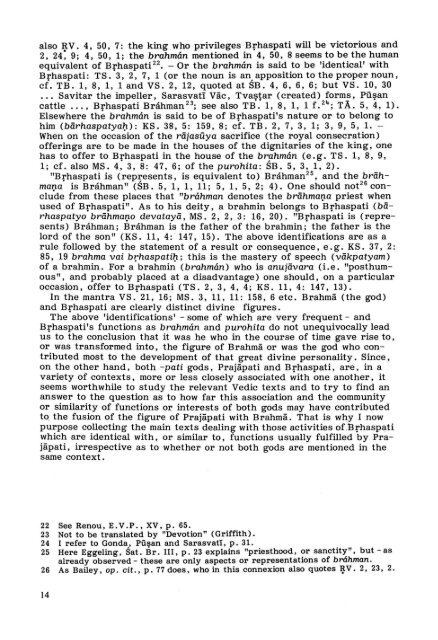Prajapati's relations with Brahman, Brhaspati and Brahma - DWC
Prajapati's relations with Brahman, Brhaspati and Brahma - DWC
Prajapati's relations with Brahman, Brhaspati and Brahma - DWC
You also want an ePaper? Increase the reach of your titles
YUMPU automatically turns print PDFs into web optimized ePapers that Google loves.
also RV. 4, 50, 7: the king who privileges <strong>Brhaspati</strong> will be victorious <strong>and</strong><br />
2, 24: 9; 4, 50, 1; the brahmán mentioned in 4, 50, 8 seems to be the human<br />
equivalent of <strong>Brhaspati</strong> 22. - Or the brahmán is said to be 'identical' <strong>with</strong><br />
<strong>Brhaspati</strong>: TS. 3, 2, 7, 1 (or the noun is an, apposition to the proper noun,<br />
cf. TB. 1, 8, 1, 1 <strong>and</strong> VS. 2,12, quoted at SB. 4, 6, 6, 6; but VS. 10,30<br />
... Savitar the impeller, Sarasvatï Väc, Tval?tar (created) forms, Pü~an<br />
cattle ... , <strong>Brhaspati</strong> Bráhman 23 ; see also TB. 1, 8,1,1 f. 21t ; TÄ. 5, 4, 1).<br />
Elsewhere the brahmán is said to be of <strong>Brhaspati</strong>'s nature or to belong to<br />
him (bärhaspatya1): KS. 38, 5: 159,8; cf. TB. 2, 7,3,1; 3,9,5,1. -<br />
When on the occasion of the räjasüya sacrifice (the royal consecration)<br />
offerings are to be made in the houses of the dignitaries of the king, one<br />
has to offer to <strong>Brhaspati</strong> in the house of the brphmán (e.g. TS. 1, 8, 9,<br />
1; cf. also MS. 4, 3, 8: 47,6; of the purohita: SB. 5,3,1,2).<br />
"<strong>Brhaspati</strong> is (rep~esents, is equivalent to) Bráhman 25 , <strong>and</strong> the brähman<br />
a is Bráhman" (SB. 5, 1, 1, 11; 5,1,5,2; 4). One should noe 6 conclu'de<br />
from these places that "bráhman denotes the brähmm;w priest when<br />
used of <strong>Brhaspati</strong>". As to his deity, a brahmin belongs to <strong>Brhaspati</strong> (bärhaspatyo<br />
brähmalJo devatayä, MS. 2, 2, 3: 16, 20). "<strong>Brhaspati</strong> is (represents<br />
) Bráhman; Bráhman is the father of the brahmin; the father is the<br />
lord of the son" (KS. 11, 4: 147, 15). The above identifications are as a<br />
rule followed by the statement of a result or consequence, e. g. KS. 37, 2:<br />
85, 19 brahma vai brhaspati1); this is the mastery of speech (väkpatyam)<br />
of a brahmin. For a brahmin (brahmán) who is anujävara (i.e. "posthumous<br />
", <strong>and</strong> probably placed at a disadvantage) one should, on a particular<br />
occasion, offer to <strong>Brhaspati</strong> (TS. 2, 3, 4, 4; KS. 11, 4: 147,13).<br />
In the mantra VS. 21, 16; MS. 3, 11, 11: 158,6 etc. Brahmä (the god)<br />
<strong>and</strong> <strong>Brhaspati</strong> are clearly distinct divine figures.<br />
The above 'identifications' - some of which are very frequent - <strong>and</strong><br />
<strong>Brhaspati</strong>'s functions as brahmán <strong>and</strong> purohita do not unequivocally lead<br />
us to the conclusion that it was he who in the course of time gave rise to,<br />
or was transformed into, the figure of Brahmä or was the god who contributed<br />
most to the development of that great divine personality. Since,<br />
on the other h<strong>and</strong>, both -pati gods, Prajäpati <strong>and</strong> <strong>Brhaspati</strong>, are, in a<br />
variety of contexts, more or less closely associated <strong>with</strong> one another, it<br />
seems worthwhile to study the relevant Vedic texts <strong>and</strong> to try to find an<br />
answer to the question as to how far this association <strong>and</strong> the community<br />
or similarity of functions or interests of both gods may have contributed<br />
to. the fusion of the figure of Prajäpati <strong>with</strong> Brahmä. That is why I now<br />
purpose collecting the main texts dealing <strong>with</strong> those activities of.<strong>Brhaspati</strong><br />
which are identical <strong>with</strong>, or similar to, functions usually fulfilled by Prajäpati,<br />
irrespective as to whether or not both gods are mentioned in the<br />
same context.<br />
22 See Renou, E. V . P . , XV, p. 65.<br />
23 Not to be translated by "Devotion" (Griffith).<br />
24<br />
25<br />
I refer to Gonda, Püsan <strong>and</strong> Sarasvatï, p. 31.<br />
Here Eggeling, Sat. ar. lIl, p. 23 explains "priesthood, or sanctity", but - as<br />
already observed - these are only aspects or representations of bráhman.<br />
26 As Bailey, op. cit., p. 77 does, who in this connexion also quotes J!,V. 2, 23, 2.<br />
14
















